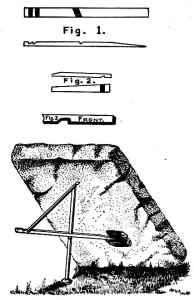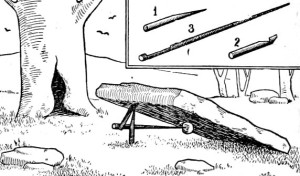The stone deadfall here described is used by trappers wherever flat stones can be found and is a good trap to catch skunk, opossum, mink and other small game in. The trap is made as follows:
The figure 4 trigger is best for this trap and is made after this manner: standard (1) is made by cutting a stick five or six inches long out of hard wood and whittling it to a flat point, but blunt at one end; (2) is about five inches long with a notch cut within about one and one-half inches of the end with the other end made square so that it will fit in (3) which is the bait stick. This is only a straight stick sixteen or eighteen inches long, while the other end of the stick should have a small prong on it, a tack driven in, or something to hold the bait in position. The best way will be to tie the bait on also.
After you have found a flat stone weighing from 50 to 100 pounds, depending upon what game you expect to trap, select the place for the trap, first place a small flat stone underneath so that your game will be killed quicker and also so that the upright trigger will not sink into the ground. Lift up the large, or upper stone, kneeling on one knee before the stone resting the weight of the stone on the other. This leaves both hands free to set the trap. This is done by placing the triggers in the position shown in illustration and then letting the stone down very easily on the triggers. You should keep your knee under the stone all the time until you see that it comes down easily and does not “go off” of its own weight. The bait should always be put on before the trap is set. This trap will go off easy and you must be careful that the bait you put on is not too heavy and will cause the trap to fall of its own accord.
This trap can be made to catch rabbits which will come in handy to bait other traps for larger game. In trapping for rabbits bait with apples, cabbage, etc.
This trap does not take long to make, as no pen need be built, the top stone is large enough to strike the animal, making no difference in what position it gets when after the bait. A stone two or three inches thick and say thirty inches across and the same length or a little longer is about the proper size for skunk, opossum, etc., but of course larger or smaller stones can be used — whatever you find convenient.
This trap consists of a flat piece of stone supported by three fits of wood, the whole trouble being in making these three fits right, and this can be done by carefully comparing the description here given with illustrations, whenever they are referred to. The parts are all made of wood about three-eighths of an inch thick.
Fig. 1 is thirteen inches long, with notches about one-sixteenth of an inch deep cut in its upper side, two of the notches near together and at one end, and another four and a half inches from the first two. The latter notch should be cut a little sloping across the stick.

Fig. 1 represents a top view and the piece next below it is a side view of the piece of wood as it should be made, and end farthest from the notches being trimmed to a point to hold the bait. This constitutes the trigger.
The lever is shown in Fig. 2, the cut above giving a side view and that below it a bottom view of this part of the trap. The piece of wood needed for it is six and one-half inches long, one inch wide at one end, and tapering down to three-sixteenths of an inch at the other; a notch is cut across the under side one and a half inches from the wide end. Level off the upper side of the narrow end to about one-half the original thickness. If the flat stone to be used is a heavy one, the notch must not be more than 1 inch from the end; otherwise the leverage on the notches would be greater than is desirable, tending to hold the parts together too rigidly.
The upright post, Fig. 3, is seven inches long, slightly forked at the bottom (to make it stand firm and prevent twisting round when in use), the upper end beveled from the front backwards at an angle of about 45 degrees. The front of the upright is the side that would face a person standing exactly opposite the trap when set.
On the right side cut a long notch, half the width of the wood in depth, commencing the hollow slope of the notch one inch from the lower end and making the square shoulder just three inches from the bottom of the post; level the shoulder off from the front so as to leave only a narrow edge. Place the post upright, it’s forked end standing on a small piece of wood or flat stone, to prevent it from sinking into the ground; bait the pointed end of the trigger and hold it up horizontally with its middle notch, catching behind the shoulder of the notch in the upright post; then place the beveled end of the lever in the notch at the end of trigger, the notch in the lever laying on the edge of the top of the upright post.
Lastly, make the stone rest on the top of the lever, arranging the stone so that the bait will be near the lower end of the stone.
It is a good plan to hollow out the ground somewhat under where the stone falls, to allow a space for the pieces of the Fig. 4 to lay without danger of being broken. The bait, also, should be something that will flatten easily and not hard enough to tilt the stone up after it has fallen.
The trouble with most deadfalls usually set, is in the weight of stone. When you get one heavy enough it will not trip easy when game takes hold, and oftentimes break head piece where the head takes hold of standard. The head piece from stone down to where standard sets in notch should be fully 2 1/4 inches, so when stone starts to fall it throws triggers out from under; otherwise, stone will catch and break them.
Deadfall Tip: Tie each pair together separately as they are finished, then when you are ready to set there are no misfits.
Now we are up to the bait stick. It should under no condition, be more than 9 inches long, and oftentimes shorter will answer better. A slotted notch on one end the width of triggers, and sharpened at the other, is all that is necessary. Then the bait will lay on the foundation of trap within 5 or 6 inches of front of the trap. Don’t put bait away back under stone. You loose all the force when it falls.
In building foundations for traps the utmost caution should be exercised in getting them good and solid. (See how well you can do it instead of how quick.) Begin in the fall before the trapping season is on, locate and build your trap, and be sure the top stone is plenty heavy, raise it up and let it fall several times to check for its strength.
< Back to Trapping & Hunting Next: Snares>

